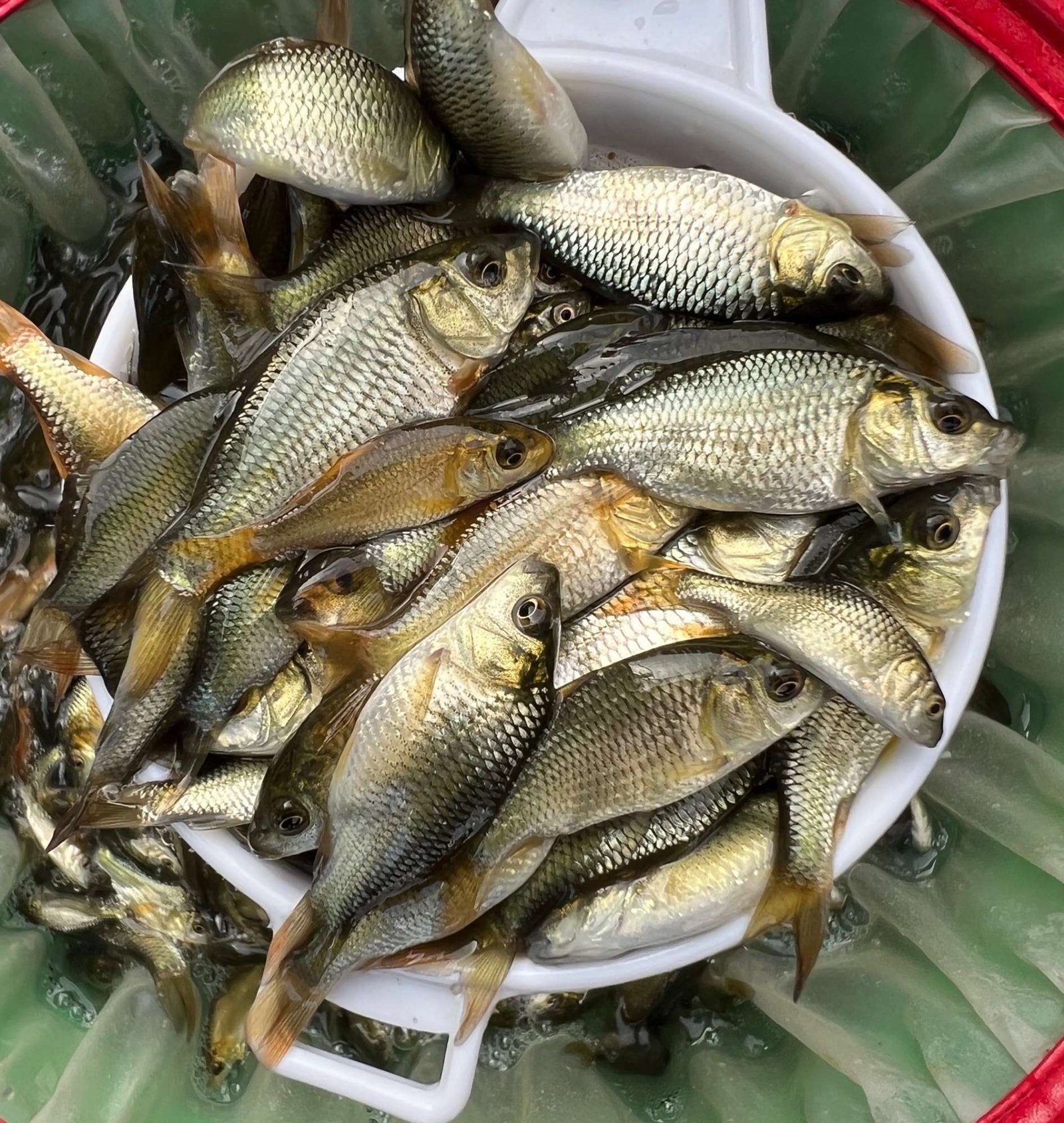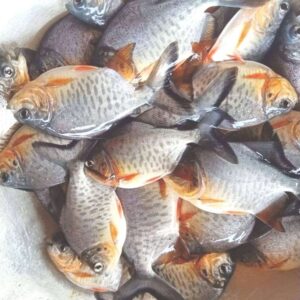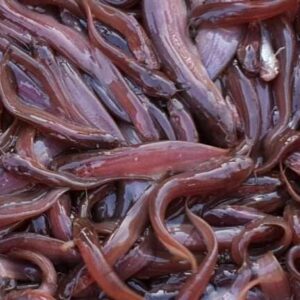Amur Carp Fish Seeds Farming: Culture, Importance, Growth Ratio, and Water Treatment
The Amur Carp (also known as black carp or Chinese carp, Ctenopharyngodon idella) is a freshwater species that originates from the Amur River basin in eastern Asia. It’s a popular choice for aquaculture due to its rapid growth, adaptability to different environments, and the variety of ways it can be raised.
Let’s break down the essential components of Amur carp fish farming, including its culture, importance, growth ratio, and water treatment.
1. Culture of Amur Carp Farming
Amur Carp are known for their rapid growth and are commonly used in aquaculture for both commercial production and ecological purposes. The culture of Amur carp involves several stages, from hatchery production to grow-out ponds.
Production Process:
-
Hatchery Management:
-
Spawning: Amur carp are typically bred in controlled environments. The fish spawn naturally in the wild, but in aquaculture, breeding is often controlled by manipulating water temperature and lighting conditions. Fertilized eggs are collected and hatched in the hatchery.
-
Fry Stage: The fertilized eggs hatch into fry (young fish). During this stage, the fry are very delicate and need optimal conditions (such as specific water temperature and oxygen levels) to thrive.
-
-
Nursing and Fingerling Stage:
-
After hatching, the fry are transferred to nursery ponds or tanks. These juvenile Amur carp are raised to a size where they can be transferred to larger grow-out ponds. The fingerlings are typically stocked at a density of 10-20 fish per square meter.
-
-
Grow-out Stage:
-
Amur carp can be grown in ponds, lakes, or cages, and they thrive in systems with adequate oxygenation and ample space. Carp are omnivores, which means they can eat a variety of food, from natural organisms in the water to formulated feed.
-
Feeding: Amur carp are fed a balanced diet that includes grains, protein sources (such as soybean meal), and sometimes live food like plankton. They are hardy feeders and can tolerate a range of feed types.
-
-
Harvesting:
-
After 12-18 months of growing, Amur carp can reach a size of 2-3 kg, though larger fish can be grown depending on environmental conditions. Harvesting is typically done through netting or trapping.
-
2. Importance of Amur Carp Farming
Amur carp have significant economic and ecological importance, especially in Asia and Eastern Europe.
Economic Importance:
-
High Market Demand: Amur carp is popular in both local markets and international trade. The fish are valued for their taste and large size, making them a sought-after commodity in the food industry.
-
Cost-Effective Aquaculture: Amur carp are highly adaptable to a range of water conditions and feed types, making them an efficient species to farm. They are relatively inexpensive to farm compared to other species of fish, providing farmers with a good profit margin.
-
Protein Source: Like other carps, Amur carp are an important source of protein for many populations, particularly in Asia, where fish is a staple part of the diet. The increasing global demand for affordable fish protein has made Amur carp farming even more attractive.
-
Multi-purpose Use: Amur carp are also farmed for stocking in recreational and ornamental ponds, as they help control aquatic plants and maintain ecological balance. This has made Amur carp important for aquatic weed control in large water bodies.
Ecological Importance:
-
Weed Control: Amur carp are also used for weed management in ponds and lakes. They feed on aquatic plants, especially in systems where overgrowth could threaten the ecosystem. As a result, they are considered important for waterway management.
-
Biodiversity Management: Due to their adaptability, Amur carp can be introduced to a wide range of environments, including ecosystems that are overrun with invasive species. However, careful management is required to avoid their becoming an invasive species themselves in certain regions.
3. Growth Ratio of Amur Carp
Amur carp are known for their fast growth rate, which is one of the primary reasons they are favored for aquaculture.
Growth Rate:
-
Fingerling to Harvest: Amur carp typically take 12-18 months to reach marketable size, which is usually around 2-3 kg. Under optimal conditions, they can reach larger sizes in some instances (up to 5 kg or more).
-
Growth Rate:
-
During the grow-out phase, Amur carp can grow approximately 0.5 to 1 kg per month. This is a significant growth rate compared to many other fish species. For example, they can grow from 5-10 cm (fry) to 30-40 cm (harvestable) in about 12 months.
-
-
Feed Conversion: Amur carp have a feed conversion ratio (FCR) of around 1.5 to 2, meaning that for every 1.5 to 2 kg of feed they consume, they gain 1 kg of body weight. This relatively low FCR indicates efficient feed conversion, making them an attractive species for commercial aquaculture.
Marketable Size:
-
The ideal market size is typically around 2-3 kg for commercial harvest, though larger fish are often raised for special markets. Farmers can harvest fish throughout the year, depending on growth rates and environmental conditions.
4. Water Treatment and Management
Good water quality is critical for successful Amur carp farming. Water management should focus on maintaining optimal conditions for growth, ensuring fish health, and preventing disease outbreaks.
Key Water Parameters:
-
Water Temperature:
-
Amur carp prefer water temperatures between 20°C and 28°C (68°F and 82°F). The optimal temperature for growth is around 25°C. Water that is too cold or too hot can stress the fish and stunt growth.
-
-
Dissolved Oxygen (DO):
-
Amur carp are oxygen-sensitive, and their growth is significantly influenced by the amount of dissolved oxygen in the water. Ideally, the DO should be kept above 5 mg/L. Aeration systems like paddlewheels or air stones are used to maintain oxygen levels, especially in dense populations.
-
-
pH Level:
-
The water pH should be between 6.5 and 8.5. Water with a pH outside this range can lead to poor fish health and reduced growth.
-
-
Ammonia and Nitrites:
-
High levels of ammonia and nitrites can be toxic to Amur carp. Ammonia levels should be kept below 0.5 mg/L, and nitrites should be kept at less than 0.1 mg/L. Regular monitoring and efficient filtration are essential to keep these levels low.
-
-
Salinity:
-
Amur carp are freshwater fish and do not tolerate high salinity. Salinity levels should be kept near 0 ppt (parts per thousand).
-
Water Treatment Systems:
-
Aeration: Maintaining high oxygen levels is critical for carp health, especially in ponds or tanks with dense fish populations. Aeration systems like paddlewheels or diffused air pumps can be used to prevent oxygen depletion.
-
Filtration: Mechanical filters are used to remove solid waste, uneaten food, and debris. Biofilters are essential for breaking down harmful substances like ammonia into safer compounds (nitrates), which can be removed or utilized by plants in aquaponic systems.
-
Water Exchange: Regular water exchanges or partial water changes (replacing 10-30% of water every week) help remove excess nutrients and maintain water quality, especially in ponds.
-
Monitoring: Regular monitoring of key water quality parameters (pH, DO, ammonia, nitrites) is crucial to prevent water quality deterioration. Automated monitoring systems are available for real-time tracking.
Conclusion
Amur carp farming is an attractive option for aquaculture due to its rapid growth, cost-effectiveness, and adaptability to various environments. The species provides numerous economic benefits by offering a high-yield protein source for markets while also playing a role in ecological management through aquatic weed control.
Proper water treatment and management are crucial to success, including maintaining optimal temperature, oxygen, and ammonia levels. By optimizing farming practices, including controlled breeding, feeding, and water quality management, farmers can achieve high growth ratios, making Amur carp a profitable and sustainable choice for aquaculture.






Reviews
There are no reviews yet.